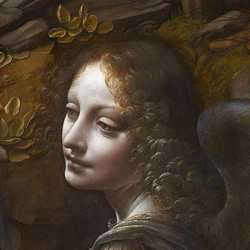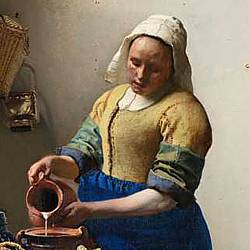Modern Art Timeline Part 1 - Impressionism to De Stijl
Our Modern Art Timeline from 1870-1930 gives an outline of the most important artists, movements and styles of painting from Impressionism to the De Stijl movement.

CLAUDE MONET (1840-1926)
'Rouen Cathedral in Full Sunlight', 1893-94
(oil on canvas)
Impressionism is the name given to a colorful style of painting in France at the end of the 19th century. The Impressionists searched for a more exact analysis of the effects of color and light in nature. They sought to capture the atmosphere of a particular time of day or the effects of different weather conditions. They often worked outdoors and applied their paint in small brightly colored strokes which meant sacrificing much of the outline and detail of their subject. Impressionism abandoned the conventional idea that the shadow of an object was made up from its color with some brown or black added. Instead, the Impressionists enriched their colors with the idea that a shadow is broken up with dashes of its complementary color.
Among the most important Impressionist painters were Claude Monet, Pierre Auguste Renoir, Edgar Degas, Camille Pissarro, Alfred Sisley and Henri de Toulouse Lautrec.

VINCENT VAN GOGH (1853-90)
'Café Terrace at Night', 1888
(oil on canvas)
Post Impressionism was not a particular style of painting. It was the collective title given to the works of a few independent artists at the end of the 19th century. The Post Impressionists rebelled against the limitations of Impressionism to develop a range of personal styles that influenced the development of art in the 20th century. The major artists associated with Post Impressionism were Paul Cézanne, Paul Gauguin, Vincent Van Gogh and Georges Seurat.
Cézanne was an important influence on Picasso and Braque in their development of Cubism. Van Gogh's vigorous and vibrant painting technique was one of the touchstones of both Fauvism and Expressionism, while Gauguin's symbolic color and Seurat's pointillist technique were an inspiration to 'Les Fauves'.

HENRI MATISSE (1869-1954)
'The Open Window, Collioure', 1905
(oil on canvas)
Fauvism was a joyful style of painting that delighted in using outrageously bold colors. It was developed in France at the beginning of the 20th century by Henri Matisse and André Derain. The artists who painted in this style were known as 'Les Fauves' (the wild beasts), a title that came from a sarcastic remark in a review by the art critic Louis Vauxcelles.
'Les Fauves' believed that color should be used at its highest pitch to express the artist's feelings about a subject, rather than simply to describe what it looks like. Fauvist paintings have two main characteristics: extremely simplified drawing and intensely exaggerated color. Fauvism was a major influence on German Expressionism.

ERNST LUDWIG KIRCHNER (1880-1938)
'The Red Tower at Halle', 1915
(oil on canvas)
German Expressionism is a style of art that is charged with an emotional or spiritual vision of the world. The expressive paintings of Vincent Van Gogh and Edvard Munch influenced the German Expressionists. They also drew their inspiration from German Gothic and 'primitive art'. The Expressionists were divided into two factions: Die Brücke and Der Blaue Reiter.
Die Brücke (The Bridge) was an artistic community of young artists in Dresden who aimed to overthrow the conservative traditions of German art. Ernst Ludwig Kirchner and Karl Schmidt-Rottluff were two of its founding members.
Der Blaue Reiter (the Blue Rider) was a group of artists whose publications and exhibitions sought to find a common creative ground between the various Expressionist art forms. Kandinsky, Marc and Macke were among its founding members.
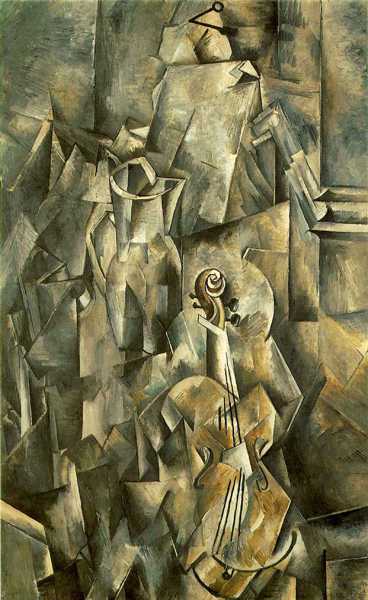
GEORGES BRAQUE (1882-1963)
'Violin and Pitcher', 1910
(oil on canvas)
Abstract Art is a generic term that describes two different methods of abstraction: 'semi abstraction' and 'pure abstraction'. The word 'abstract' means to withdraw part of something in order to consider it separately. In Abstract art that 'something' is one or more of the visual elements of a subject: its line, shape, tone, pattern, texture, or form.
Semi-Abstraction is where the image still has one foot in representational art, (see Cubism and Futurism). It uses a type of stylisation where the artist selects, develops and refines specific visual elements (e.g. line, color and shape) in order to create a poetic reconstruction or simplified essence of the original subject.
Pure Abstraction is where the artist uses visual elements independently as the actual subject of the work itself. (see Suprematism, De Stijl and Minimalism).
Although elements of abstraction are present in earlier artworks, the roots of modern abstract art are to be found in Cubism. Among other important abstract styles that developed in the 20th century are Orphism, Rayonism, Constructivism, Tachisme, Abstract Expressionism, and Op Art.

PABLO PICASSO (1881-1973)
'Ambroise Vollard', 1915
(oil on canvas)
Cubism was invented around 1907 in Paris by Pablo Picasso and Georges Braque. It was the first abstract style of modern art. Cubist paintings ignore the traditions of perspective drawing and show you many views of a subject at one time. The Cubists believed that the traditions of Western art had become exhausted and to revitalize their work, they drew on the expressive energy of art from other cultures, particularly African art.
There are two distinct phases of the Cubist style: Analytical Cubism (pre 1912) and Synthetic Cubism (post 1912). Cubism influenced many other styles of modern art including Expressionism, Futurism, Orphism, Vorticism, Suprematism, Constructivism and De Stijl. Other notable artists associated with Cubism were Juan Gris, Fernand Leger, Robert Delaunay, Albert Gleizes, Jean Metzinger, Louis Marcoussis and Marie Laurencin.

GIACOMO BALLA (1871-1959)
'The Rhythm of the Violinist', 1912
(oil on canvas)
Futurism was a revolutionary Italian movement that celebrated modernity. The Futurist vision was outlined in a series of manifestos that attacked the long tradition of Italian art in favour of a new avant-garde. They glorified industrialization, technology, and transport along with the speed, noise and energy of urban life. The Futurists adopted the visual vocabulary of Cubism to express their ideas - but with a slight twist. In a Cubist painting the artist records selected details of a subject as he moves around it, whereas in a Futurist painting the subject itself seems to move around the artist. The effect of this is that Futurist paintings appear more dynamic than their Cubist counterparts.
Futurism was founded in 1909 by the poet Filippo Tommas Marinetti and embraced the arts in their widest sense. The main figures associated with the movement were the artists, Umberto Boccioni, Giacomo Balla, Gino Severini, the musician Luigi Russolo and the architect Antonio Sant'Elia.
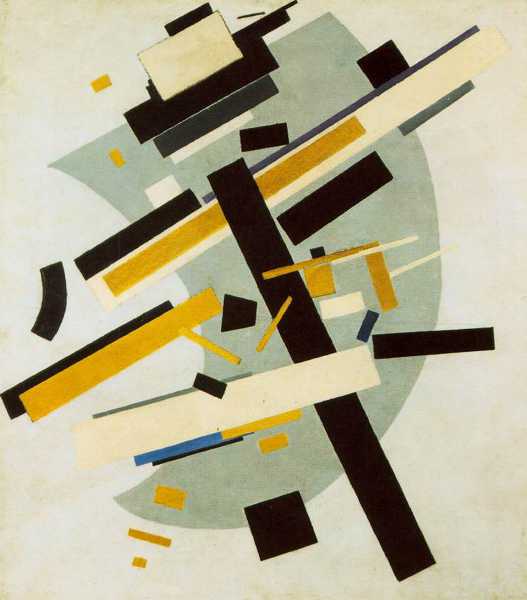
KAZIMIR MALEVICH (1879-1935)
'Suprematism', 1915
(oil on canvas)
Suprematism was developed in 1915 by the Russian artist Kazimir Malevich. It was a geometric style of abstract painting derived from elements of Cubism and Futurism. Malevich rejected any use of representational images, believing that the non-representational forms of pure abstraction had a greater spiritual power and an ability to open the mind to ‘the supremacy of pure feeling’.
Suprematism was a style of pure abstraction that advocated a mystical approach to art, in contrast with Constructivism, the major Russian art movement of the 20th Century, whose imagery served the social and political ideology of the state.
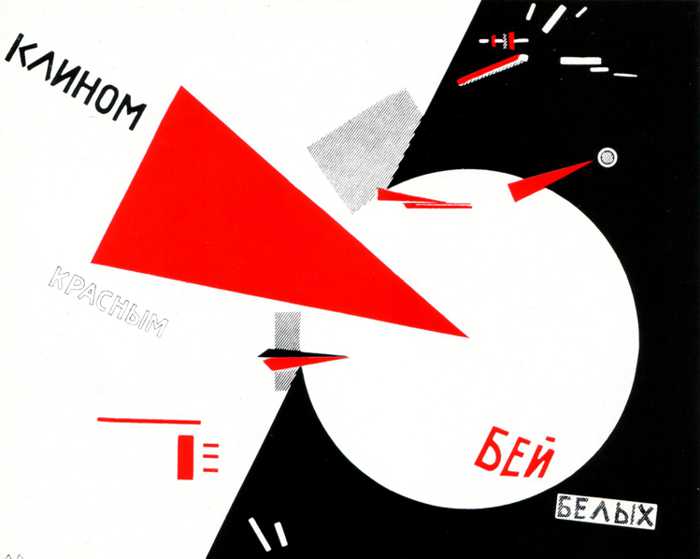
EL LISSITZKY (1890-1941)
'The Red Wedge', 1919
(lithograph)
Constructivism used the same geometric language as Suprematism but abandoned its mystical vision in favour of their 'Socialism of vision' - a Utopian glimpse of a mechanized modernity according to the ideals of the October Revolution. However, this was not an art that was easily understood by the proletariat and it was eventually repressed and replaced by Socialist Realism. Tatlin, Rodchenko, El Lissitzky and Naum Gabo were among the best artists associated with Constructivism.

PIET MONDRIAN (1872-1944)
'Composition with White and Yellow', 1942
(oil on canvas)
De Stijl was a Dutch 'style' of pure abstraction developed by Piet Mondrian, Theo Van Doesburg and Bart van der Leck.
Mondrian was the outstanding artist of the group. He was a deeply spiritual man who was intent on developing a universal visual language that was free from any hint of the nationalism that led to the Great War.
Mondrian gradually refined the elements of his art to a grid of lines and primary colors which he configured in a series of compositions that explored his universal principles of harmony. He saw the elements of line and color as possessing counteracting cosmic forces. Vertical lines embodied the direction and energy of the sun's rays. These were countered by horizontal lines relating to the earth's movement around it. He saw primary colors through the same cosmic tinted spectacles: yellow radiated the sun's energy; blue receded as infinite space and red materialized where blue and yellow met. Mondrian's style which he also called 'Neo-Plasticism' was inspired by the Theosophical beliefs of the mathematician and philosopher, M.H.J. Schoenmaekers.

